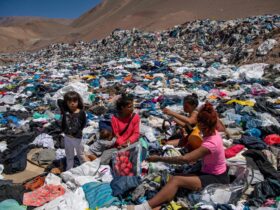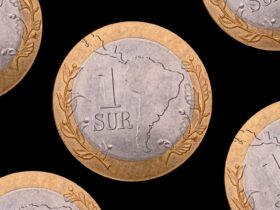LOS ANGELES — Amid the pandemic and critical discussions on the global impact of climate change, Latin American countries are doubly feeling the effects of both crises. The region has felt the sharp impact of the pandemic’s financial blows, and ballooning debt complicates efforts to mitigate the public health emergency.
But faced with this convergence of crises, Latin American countries are now at the COP26 summit in Glasgow, Scotland with a proposed solution: debt-for-climate action swaps.These swaps would allow these countries to gain access to more funding for climate projects that reduce carbon emissions, while simultaneously reducing their growing debt.
Debt-for-climate action swaps are designed to allow nations to pay off their debt by redirecting the money they owe into climate action projects. Creditor nations will reduce debt “either by converting it into local currency, lowering the interest rate, writing off some of the debt, or through a combination of all three.” The debtor country will then redirect the saved revenue towards climate action projects such as preserving biodiversity or reducing carbon emissions.
These initiatives have a history of success for both parties. However, given the growing severity of climate change, these agreements ought to be reformed to create lasting and sustainable incentives for growth. Most critically, debt-for-climate action swaps should increase the amount of debt “forgiven” in order for countries to fund the large-scale, and realistically expensive, projects needed to tackle climate change. The scale of debt-for-climate action swaps must be reconfigured to match the scale of impending climate catastrophe.
Additionally, these agreements should include a mechanism to monitor countries and ensure that governments are meeting their emission goals. Holding borrowing countries to their environmental commitments appears especially crucial as countries like Argentina call for increased debt-for-nature swaps, even as they remain reliant on fossil fuels and fail to comply with their climate pledges.
Latin America’s economic struggle amid COVID-19 drained funding for climate change projects. In fact, according to the United Nations Economic Commission for Latin America and the Caribbean, the region’s GDP dropped by 7.7% and is not expected to recover until 2024. Since there is a limit on the amount of debt that a country can incur, loans were taken out to help fund the region’s economic and health sectors. For many of these countries, climate change mitigation projects were forced onto the backburner.
For instance, Honduras took out loans to deal with the public health costs incurred by COVID-19. For the country, which feels the impact of climate change through increasingly severe hurricanes and droughts, increasing costs in other sectors limited the amount of loans directed toward initiatives and policies focused on climate resiliency.
With Latin American countries already laden with debt and struggling economies, debt-for-climate action swaps provide a viable solution to help reduce their debt and free up revenue that can be applied to projects to reduce their emissions.
These swaps began in 1989 and have been largely successful. Stockholm University economists found that “since 1990, debt-for-nature swaps globally have raised at least $900 million for conservation, erased nearly $3 billion in debt in at least 21 low- and middle-income countries and resulted in statistically significant reductions in deforestation.”
In 2005, Uruguay exemplified how debt swaps can potentially fund climate projects. In a debt-for-clean energy swap with Spain, a portion of Uruguay’s debt was swapped in exchange for the installation of solar equipment. As a result, Uruguay now ranks among the cleanest energy systems in Latin America, producing more than 97% of its electricity from renewable sources.
Uruguay’s success demonstrates how these initiatives can be advantageous for Latin America going forward. But, it is crucial to consider the risks involved with these swaps and address the need to increase the scale of debt swaps.
First, it is difficult to verify if a country is hitting its goals for carbon offsets, and there is a risk of countries “greenwashing” how they use the funds. Similar to accountability issues plaguing the nature-based carbon offset market, risks of countries claiming to have protected forests that were in fact never vulnerable to deforestation obscure measurements of these swaps’ efficacy.
Though satellites and land-based technologies can help monitor carbon emissions to ensure that countries are putting this money toward meaningful initiatives to offset their emissions.
Furthermore, the magnitude and urgency of the climate crisis now dwarfs previous debt swap efforts.
The Institute for Governance and Sustainable Development states that billions of dollars of debt will need to be restructured or forgiven to tackle existing climate challenges. Currently, swaps occur at or under $50 million. For example, Seychelles, an archipelago off the coast of East Africa, recently used a debt for nature swap to erase around $22 million dollars of debt in exchange for creating 13 new marine protected areas. While pollution and overfishing severely threatened the biodiversity in the area and made this swap necessary, ongoing destruction and depletion of marine ecosystems in Seychelles and worldwide reveal the insufficiency of current debt-for-climate action swap efforts.
Latin American leaders will need to implement debt-for-climate action swaps at drastically larger levels than ever before. This debt reduction is especially important in developing countries where there is “toxic indebtedness,” according to Argentinian President Alberto Fernández, which refers to the debt crisis that Argentina has faced since 2018 and the increased spending among Latin American countries because of COVID-19.
Climate-for-debt swaps have the potential to create meaningful change and are desperately needed in a time when Latin America’s economy is struggling. With the consequences of climate change fast approaching, debt-for-climate action swaps are one way — among many — to tackle the climate crisis.
And for Latin America, solutions are needed now more than ever. According to a news report by the UN, deforestation and forest fires are major concerns, both locally and globally, considering Latin America is home to 57% of the world’s forests, storing approximately 104 gigatons of carbon. According to the World Meteorological Organization Secretary-General Professor Petteri Taalas, “[f]ires and deforestation are now threatening one of the world’s largest carbon sinks, with far-reaching and long-lasting repercussions.”
The UN news report also points out that 27% of the population in Latin America and the Caribbean live along coastal shores, which now face mounting threats from ocean acidification, climbing temperatures and rising sea levels. Droughts across Latin America and the Caribbean have also impeded inland shipping routes, reduced crop yield and limited food production and distribution, exacerbating food insecurity in many communities throughout the region. These are only some of the consequences of climate change already endangering Latin America, and their severity will only worsen without urgent, sweeping action.
If the world hopes to meet its carbon emission reduction goals — as world leaders have recently debated at COP26 — these swaps must be considered, reformed and implemented as one tool in the toolbox.







